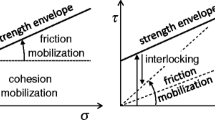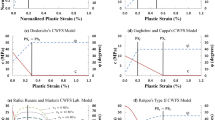Abstract
The creation of microfractures within rock is commonly observed as rock is strained. The presence of these microfractures constitutes damage to the rock, and this damage can reduce the rock’s strength. This paper explores the evolution of rock strength as microfractures within a rock accumulate. Two approaches involving different laboratory tests are used to study how cohesion and internal friction evolve during progressive damage to rock. The mobilized cohesion and friction angle are measured for intact and damaged rock specimens. Intact rock specimens tested under compression were used to determine the peak values of cohesion and friction angle for two types of rock. Specimens of rock with varying amounts of accumulated microfracture damage were tested under direct shear or multi-stage triaxial compression to measure the Coulomb strength parameters for damaged rock. The laboratory testing shows that cohesion decreases with strain as the rock accumulates internal damage caused by microfracturing before the peak strength. The frictional component of the rock strength starts to be mobilized as strain causes internal microfractures. The mobilized internal friction angle increases up to and slightly beyond the peak strength. A small amount of post-peak strain is required to initiate macroscopic slip surfaces, and until these are created, high frictional resistance is mobilized between the many interacting and interlocked pieces of rock in the test specimen. With further post-peak strain, the friction angle decreases as the macroscopic slip surfaces in the rock become well established.













Similar content being viewed by others
References
Hajiabdolmajid V, Kaiser PK, Martin CD (2002) Modelling brittle failure of rock. Int J Rock Mech Min Sci 39(6):731–741
Hajiabdolmajid V, Kaiser PK, Martin CD (2003) Mobilised strength components in brittle failure of rock. Geotechnique 53(3):327–336
Hudson JA, Brown ET, Fairhurst C (1972) Shape of the complete stress-strain curve for rock. In: Cording EJ (Ed) Proceedings of 13th US Symposium on Rock Mechanics, ASCE, p 773–795
Kaiser PK, Yazici S, Maloney S (2001) Mining-induced stress change and consequences of stress path on excavation stability—a case study. Int J Rock Mech Min Sci 38(2):167–180
Kovari K, Tisa A (1975) Multiple failure state and strain controlled triaxial tests. Rock Mech Rock Eng 7(1):17–33
Kovari K, Tisa A, Einstein HH, Franklin JA (1983) Suggested methods for determining the strength of rock materials in triaxial compression: revised version. Int J Rock Mech Min Sci Geomech Abstr 20(6):285–290
Li YH, Zhang HQ, Tang CAYuQL, Zhao ZY (2006) A new numerical approach for studying self-organized criticality behavior in rock failure process. Comput Methods 1–2:1841–1846
Martin CD, Chandler NA (1994) The progressive fracture of Lac du Bonnet granite. Int J Rock Mech Min Sci Geomech Abstr 31(6):643–659
Niu SJ, Jing HW, Yang XX, Yang S (2012) Experimental study of strength degradation law of surrounding rock in fractured zone of deep roadway. Chin J Rock Mech Eng 31(8):1587–1596
Rao NGM, Murthy CRL (2001) Dual role of microcracks: toughening and degradation. Can Geotech J 38(2):427–440
Schmertmann JH, Osterberg JH (1960) An experimental study of the development of cohesion and friction with axial strain in saturated cohesive soils. Research Conference on Shear Strength of Cohesive Soils, ASCE, p 643–694
Schofield AN (1998) The Mohr-Coulomb error. In: Luong (ed) Mechanics and Geotechnique, LMS Ecole Polytechnique, pp 19–27. http://www-civ.eng.cam.ac.uk/geotech_new/people/ans/habibx.html
Su CD, Yang SQ (2006) Experimental study on deformation and strength characteristics of rock specimens under cyclic loading and unloading. J Hohai Univ (Nat Sci) 34(6):667–671
Terzaghi K, Peck RP, Mesri G (1996) Soil mechanics in engineering practice, 3rd edn. Wiley, New Jersey
Zhang HQ, He YN, Liu ZQ, Zhou JJ, Han LJ (2008) Study of material failure and strength degradation in argillaceous packsand samples. J China Uni Min Tech 37(1):129–133
Zhang HQ, Nunoo S, Tannant DD, Wang SY (2014) Numerical study of the evolution of cohesion and internal friction in rock during the pre-peak deformation process. Arabian J GeoSci. doi:10.1007/s12517-014-1508-6
Zhou YH, Zhou DP, Yang T, Feng ZJ (2005) Experimental investigation on shear strength parameters of jointed rock mass. J Southwest Jiaotong Univ 40(1):73–76
Zong YJ (2013) Study on creep mechanical properties and constitutive model of deep cracked surrounding rock. PhD thesis, China University of Mining and Technology
Acknowledgments
This research work is supported by 973 Program of the China (No. 2013CB227900, 2013CB036003), NSFC (No. 51474215, 51174196, 51227003 and 51104151), 111 Project (No. B07028), Research Fund for the Doctoral Program of Higher Education of China (No. 20120095110013) and The Outstanding Innovation Team of China University of Mining and Technology (No. 2014QN003). The first author is also grateful for the sponsorship of Jiangsu Overseas Research and Training Program for University Prominent Young and Middle-aged Teachers and Presidents. The first author would also like to acknowledge UBC Okanagan for the assistance given him to be part of the institution as a visiting professor (2013.3-2014.3). The authors thank the anonymous reviewers for their comments, which have significantly helped to improve this paper.
Author information
Authors and Affiliations
Corresponding author
Rights and permissions
About this article
Cite this article
Zhang, H.Q., Tannant, D.D., Jing, H.W. et al. Evolution of cohesion and friction angle during microfracture accumulation in rock. Nat Hazards 77, 497–510 (2015). https://doi.org/10.1007/s11069-015-1592-2
Received:
Accepted:
Published:
Issue Date:
DOI: https://doi.org/10.1007/s11069-015-1592-2




